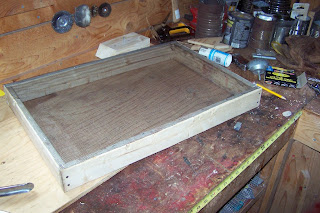I like to set aside time on Sunday to be a "book farmer". I try to keep up with the information that comes to me in the books we've collected, the magazines and news letters that come in the mail and the blogs I read for insight and inspiration. Sunday is also the day people here go visiting. I've just set down my reading to put a stick of wood on the fire. And now I'm ready to enjoy a long overdue visit with you.
Have you seen this?
I first read Anne and Eric Nordell's artilce, "Weed the Soil not the Crop" in the Summer, 2006 issue of Small Farmer's Journal (a similar article with the same title, written by the couple, is currently available at: Acres USA).
I started experimenting with their ideas as best I could using my tools and know how (both of which are limited) back in Spring 2007. I was just re-reading that article today and refreshing myself on their approach.
I can say that the parts of this method that we incorporated as directed worked well for us. And I was reminded that we aren't finished mixing these ideas into our work. I've been wondering how to begin writing our farm plan for 2011. This is a great place to start.
You Can Build These Stackable Drying Racks!
Many of the things we harvest in Fall need to be dried before they can be properly stored. Space for drying beer hops or seed corn or baking beans or wild rose hips is at a premium in our house. Could you use some extra space to dry herbs or your own garden produce too? Well, maybe winter might be a good time for you to try (and improve) this project made with hand tools and regular dimensional lumber.
I borrowed several good ideas to make this design work. In particular, I liked the idea of making a rack size that would fit into an oven. They can easily be stacked over or near an air vent too, making double use of your heating or cooling system.
24"x16" Stackable Drying Rack - Materials Per Tray:
2 24" 1x2 for frame
 2 14-1/2" 1x2 for frame
2 14-1/2" 1x2 for frame4 4-1/2" right triangles (I used 1/2" plywood) as corner braces
4 5" 1x2 for legs
4 2-1/2" 1x2 rack spacers for legs
8 box nails (screws would be good too)
16 shingle nails (or screws)
Staples for fastening screen to frame (I used a staple gun - tacks could work too)
24" x 16" plastic window screen
I started by pre-cutting enough pieces for several trays. Then, using a flat surface and a square I drilled pilot holes and then hammered in two nails in each corner.
After squaring the frame again, I used a blade to cut the 4' screen down to 24" by 16". Since 24" is half of four feet, I could use the nice factory cuts on either edge of the screen. Then I stapled it to the frame.
To give the tray frame strength and help secure the corners, I used the triangle shapes mounted over the screen and nailed them directly to the frame with shingle nails.
I fastened a rack spacer in the exact center of each leg, then mount the legs right tight up to the frame. This is what makes the trays stackable, so be careful how you measure. To make all the legs lineup in the stack I built the first one and then eye-balled all the others to match it. I'm no finish carpenter. This was my attempt to create a simple and inexpensive design that serves a useful purpose. These racks do create a large amount drying area in a small space. And they do look nice enough for Susan to allow them in the kitchen!
Notes and Suggestions
You may want to choose a more natural material than window screen. And be aware that stapled plastic screen will not support the weight of a curious cat plus whatever it is that you are drying!
The bottoms can be strengthened by trussing them with wire, fishing line, string...whatever material you
are comfortable with. A cover might be a good idea too
So Long 'till Next Time!
Thank you for stopping in to visit. I hope we'll be getting together again soon.











6 comments:
Hi John!
Could you parlay more information on drying food?
I always thought it would be too humid here in PEI to dry anything naturally, but you also mentioned putting the rack into the oven.
Hope you're having a great PEI winter so far!
These drying racks are very similar to the ones grandpa used to dry nuts and beans. He however built them onto the wall and pulled each rack out in a drawer like fashion. How many acres is your farm John? I enjoyed reading your blog and will bookmark it for future reads.
Heard your voice when I went to the dentist for a root canal (which I didn't get) but hearing you made me smile, and took me down memory lane. Sounds like all is well with you and yours. I am glad to hear it.
~Dayna in Nipomo California
Hi Dayna -
Wow! How great to hear from you!
I laughed when I read that you heard my voice and went from Root Canal to Memory Lane. How funny!
I'm glad you found the blog and stopped to leave a message. My
Memory Lane winds through Oakley Ranch and the good times you were part of helped me find my way here.
We live on 123 acres. About 30 is cleared and the rest is woods, creeks, bog, etc. Right now it's covered in snow!
It'd be nice to catch up some time.
Hope you'll stay in touch.
Hi Kim -
What I know about drying is the trial and error we've been doing.
We have an electric food dryer/dehydrator that works well for some things, like the Italian parsley we dried from fresh.
So far I find the racks are most handy for things that need to finish drying, but can't finish in the field because of rain or birds, etc.
We grew Kenearly baking baking beans last summer. The beans that were shelled by hand from dry pods were still a bit too damp for storage. So we put them on the racks and they finished nicely within about a week.
I did size these trays to fit in the oven so that I could speed up drying. But I've been reading that heat much above, say, 120 F can remove volatile oils and natural flavor. So it's not about raising heat so much as lowering moisture.
Moving air from a window, fan or air vent helps a lot. My goal is getting things dry enough to store. PEI seems to be fine for that.
Hey John, just stopping by and wish you and Susan and family a happy, healthy, and productive 2011!
Cheers from PNW,
Jade
PS - thanks for the detailed drying rack info :)
Jade -
Thanks for stopping in! Saw some of your blogging and lovely photos!
Still have my hand in voice over, narrations and I am planning a new podcast series too.
I see you're busy too!
Happy New Year! Keep in touch.
Post a Comment